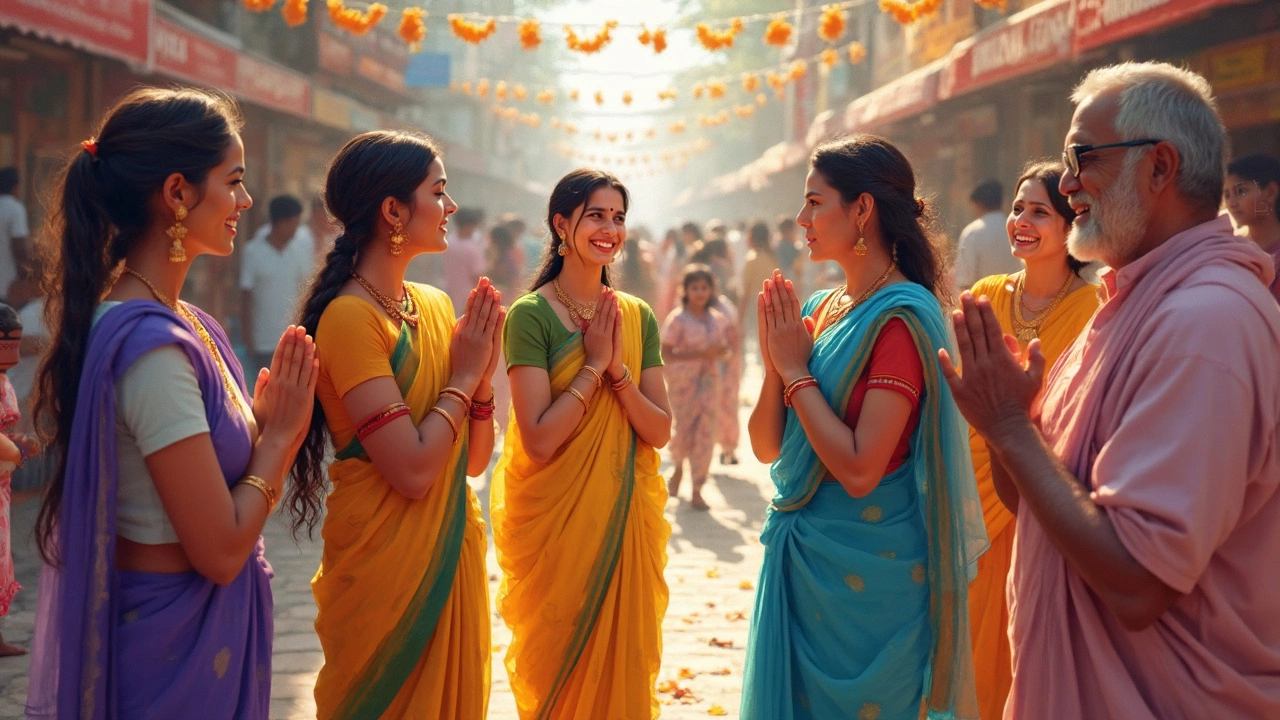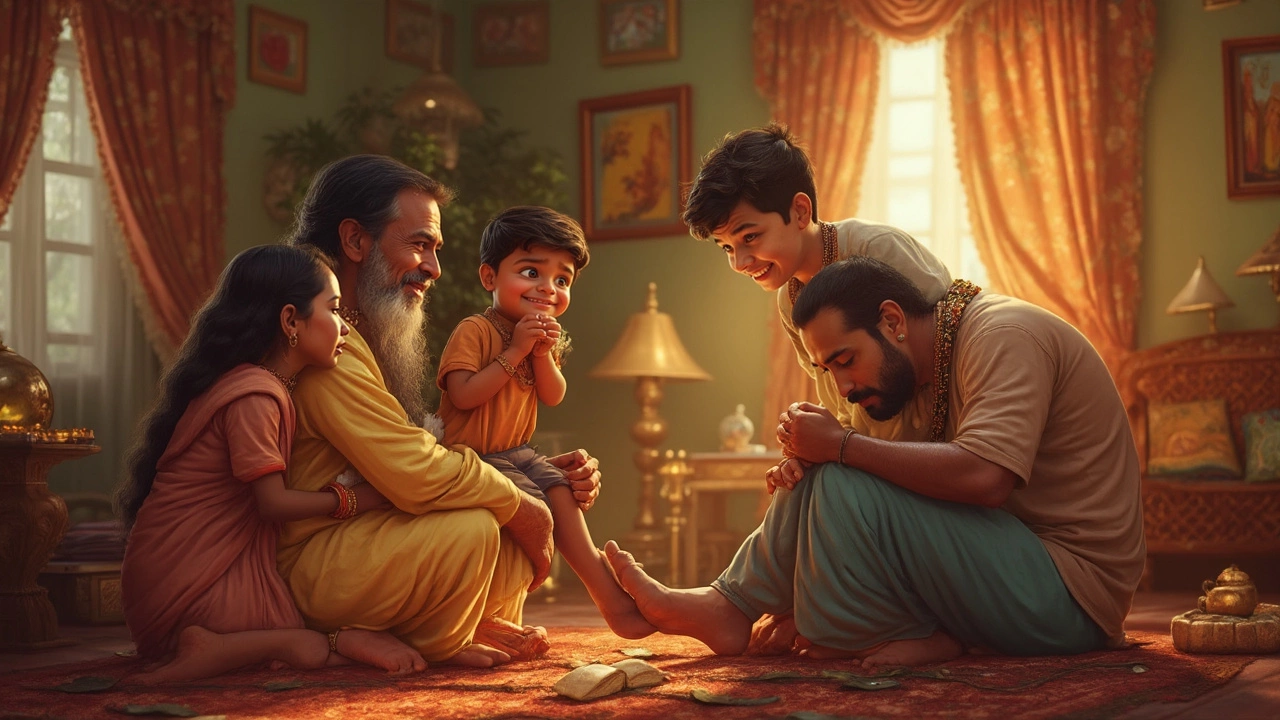
You might think a simple 'hi' works everywhere, but in India, greetings are a whole other story. Forget one-size-fits-all. From Delhi to Chennai, how you say hello says a lot about how you feel, your respect level, and who you’re talking to. Sure, young Indians throw around 'hi' and 'hello', but that’s just the tip of the iceberg.
If you walk into a family gathering and shout 'hi', you might get a few smiles, but sometimes you’ll see raised eyebrows, especially from elders. Why? Because greeting someone here is loaded with meaning. The way you say hello can build trust, show love, or even make things a little awkward if you get it wrong.
Knowing when to use 'hi', stick to a more traditional greeting, or mix things up can open doors (sometimes quite literally). It's not just about the words. It’s about showing the right kind of respect, warmth, or friendship. And honestly, those first few seconds set the tone, whether you’re meeting friends, your partner's family, or joining a big wedding party. Ready to understand what really works when you meet people in India? Let's get into it.
- The ‘Hi’ Question: What Works in India?
- Classic Indian Greetings and Their Meanings
- Greeting with Heart: Love and Respect in Everyday Hellos
- Actions Speak: Body Language and Gestures
- Tips: Greeting People Like a Local
The ‘Hi’ Question: What Works in India?
So, can you just say hi in india and call it a day? Well, yes and no. Big cities like Mumbai and Bengaluru have young crowds who use 'hi' all the time, especially in offices, colleges, and when texting. But outside these urban bubbles, it isn’t always the go-to. If you visit small towns or meet someone’s parents, a straight-up 'hi' feels kind of flat, even out of place.
In India, greetings depend a lot on the relationship and the setting. Greet a friend or a coworker with 'hi'—no problem. Arrive at your partner’s house and say the same to their grandparents? That’s risky. Most elders expect something a little deeper, like ‘Namaste’, which signals respect in an instant. You’re not being old-fashioned or dramatic; you’re showing you get how things work here.
Here’s a quick look at where ‘hi’ fits in and where it doesn’t:
- Younger people (teens to 30s): 'Hi' and 'hello' are totally fine, but when talking to elders, many still switch to a more traditional greeting.
- In work emails or chats: 'Hi' is catching on, especially in startups or with international teams. But job interviews or formal meetings? Play it safe, start with ‘Good morning’ or 'Namaste.'
- Social events: If you’re unsure, follow what locals do. Sometimes you’ll see friends say 'hi' but greet elders with a folded-hands gesture and a ‘Namaste’.
If you’re not sure what’s normal, just look around. Indians are super quick to spot someone trying, even if you mess up. But if you come in with a smile and a respectful greeting, you’ll rarely go wrong. Want to blend in faster? Learn one or two local greetings—immediate brownie points.
Here's a peek at how people greet each other around India:
| Greeting | Where Commonly Used | Typical Context |
|---|---|---|
| Hi | Urban centers, youth circles | Casual, friends, colleagues |
| Namaste | All over India | Respectful, elders, formal events |
| Vanakkam | Tamil Nadu | Formal or family |
| Salaam | Muslim communities | Formal, respectful |
| Sat Sri Akal | Punjab | Respectful, community events |
Classic Indian Greetings and Their Meanings
India isn’t just about 'hi' and 'hello.' Local languages and traditions mix things up, and each greeting has its own vibe. The most well-known is 'Namaste.' You press your palms together, fingers pointing up, and nod a bit. It means, 'I bow to you.' This isn’t just a fancy way to say hello; it’s about respect and good vibes. You’ll hear 'Namaste' mostly in the north and among people who want to keep things respectful, especially with elders or strangers.
Down south, people say 'Vanakkam' in Tamil Nadu or 'Namaskara' in Karnataka. The gesture looks the same—palms joined—but the words match the local language. If you’re in Maharashtra, 'Namaskar' is the go-to, and in Punjab, folks greet with 'Sat Sri Akal.' Sikhs say this as a sign of both hello and mutual warmth. Over in Bengal, you’ll catch 'Nomoskar,' and in Kerala, it’s 'Namaskaram.'
You might be surprised, but many regular folks now mix English and Indian greetings. So it’s normal to hear someone say, 'Hi aunty, Namaste!' in the same breath. Still, the traditional greetings hold a lot more weight with older generations, at religious places, or at formal gatherings.
Here’s a quick table showing how people greet each other across a few major states:
| Region | Greeting Word | Language |
|---|---|---|
| North India | Namaste | Hindi |
| Punjab | Sat Sri Akal | Punjabi |
| Tamil Nadu | Vanakkam | Tamil |
| Karnataka | Namaskara | Kannada |
| Kerala | Namaskaram | Malayalam |
| West Bengal | Nomoskar | Bengali |
If you want to make a good impression, remember: use the local greeting in local language when you can. Don’t stress about perfect pronunciation. People love it when you try. If you forget, just say 'Namaste'—it’s understood just about everywhere and shows you care about tradition.

Greeting with Heart: Love and Respect in Everyday Hellos
Indians don’t just say hello; they show how much they care in the way they greet. It’s pretty common to hear people say hi in India, especially among the younger crowd or in big cities. But if you’re around elders or meeting someone you want to impress, the greeting is a totally different game.
The classic “Namaste” isn’t just a yoga class cliché. In India, pressing your palms together and giving a small bow is a simple way to show respect and warmth. It literally means “I bow to you.” You’ll see families using it with grandparents, teachers, and even strangers in some parts of the country.
Love shows up in greetings, too. In a close circle of family or friends, hugs, kisses on the cheek, or a back pat are normal. But don’t overdo the public hugs, especially in smaller towns—people often stick to a smile or a nod.
Ever heard of “Pranam” or “Touching Feet”? In many Indian homes, kids touch the feet of elders as soon as they come in. It sounds old school, but it’s a sign of huge respect and is still super common, especially during holidays or big family events.
The words matter, but how you say them matters more. Tone and eye contact are big here. Most folks use softer voices and a gentle smile. If you’re meeting your partner’s parents, showing all this care is a non-negotiable!
Check out some greetings and what they mean:
- Namaste/Namaskar: Respectful and all-purpose, works for any age or occasion.
- Salaam: Used mostly in Muslim families, it means peace.
- Satsriakal: Punjabi greeting, warm and welcoming.
- Vanakkam: If you’re in Tamil Nadu, this one shows you paid attention to local vibes.
Customizing how you greet people unlocks relationships. Tourists who use the local greetings always look more friendly and get better responses. If you remember someone’s preferred greet, you’re already winning at Indian hellos.
Actions Speak: Body Language and Gestures
Saying 'hi' in India isn’t just about what rolls off your tongue. People here pay a lot of attention to body language, and sometimes, that's what really makes your greeting count.
The classic Indian greeting is the namaste: you press your palms together, fingers pointing up, and give a little nod. It’s not just for yoga class—it’s a daily thing, especially when meeting elders or at formal events. In South India, people often say 'vanakkam' or 'namaskaram' with the same gesture.
If you’re meeting someone for the first time, don’t rush in for a hug or handshake unless they offer first. In some circles, handshakes are common—especially among men or in business—but skipping them never hurts. And with women, it’s safer to just go for a smile and a namaste unless you know what’s comfortable for them.
- hi in india can be a little more relaxed among friends, often with a casual wave or playful fist bump.
- Avoid touching someone’s head or feet, unless it’s a close family ritual where touching elders’ feet is a sign of huge respect.
- Direct eye contact is good, but staring too long can feel awkward or even rude—people usually keep it friendly and brief.
Ever noticed how people sometimes tilt their heads while talking? The famous Indian head wobble can mean yes, agreement, or just being polite. If you're unsure, notice the rest of the body language—it usually helps you get what’s being said without words.
To see how these greetings play out, check what big companies and hotels do. You’ll spot staff greeting everyone with a namaste and a smile—it’s warm, respectful, and puts everyone at ease.
| Gesture | Region | Common Context |
|---|---|---|
| Namaste | All over India | Formal, elders, strangers |
| Vanakkam/Namaskaram | South India | Formal, traditional |
| Handshake | Urban, business | Work, friends (some circles) |
| Head wobble | Mostly everywhere | Agreement, politeness |
If you’re ever lost on how to greet, just watch what others are doing first. You’ll catch the vibe fast and avoid sticking out like a sore thumb.

Tips: Greeting People Like a Local
Getting greetings right in India isn’t hard, but you’ve got to know a few things to avoid looking clueless. This is especially true if you care about respect—everyone picks up fast on whether you’ve put in even the tiniest effort. Here’s how to make your hello count.
- If you’re meeting elders, stick with ‘Namaste’ or ‘Namaskar.’ Push your palms together and give a small nod. People instantly appreciate the respect, even if your accent’s off.
- In casual settings, especially among young folks, ‘hi’ and ‘hello’ are fine. But if you want to make a good impression, try mixing in a local word like ‘Namaste’ or, in the South, ‘Vanakkam’ or ‘Namaskaram.’
- Physical contact can get tricky. Skip the handshake if you’re unsure—lots of people, especially older women and some men, prefer no touch at all. Young folks may go for handshakes or even hugs with friends, but don’t jump the gun.
- Start formal. If you’re not sure which greeting to use, stick to the formal one first. Let the other person break the ice if they want to get casual.
- Don’t just toss a greeting and walk away—folks expect a short exchange. Ask, ‘How are you?’ or ‘Sab thik hai?’ It shows warmth, not just politeness.
- This one’s a game-changer: Use the right language for the area if you know it. In Maharashtra, ‘Namaskar’ works. In Bengal, say ‘Nomoshkar.’ If you’re in Punjab, give them a ‘Sat Sri Akal.’ Locals really love it when you try.
According to a travel survey by MakeMyTrip in 2023, nearly 72% of Indian respondents noticed when tourists greeted them in their own language or dialect—and almost all said it instantly made the conversation feel friendlier. That little effort? It pays off.
And don’t forget, non-verbal stuff matters too. Smile when you greet. A warm smile does half the work. If you want to sound local, keep your tone gentle and let your eyes show friendliness, not just your words.
If in doubt, just take a second and watch how people around you greet each other. You’ll pick up on what’s normal in that setting fast. Remember, greeting isn’t about showing off—it’s about making folks comfortable. Want to blend in? Just slow down, watch, and use a hi in india—or its local twin—the right way.